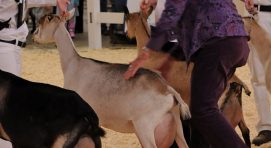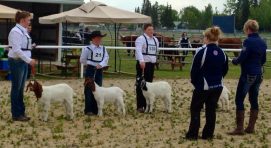 Lots of planning and preparation goes into getting ready for a show. However, breeders need to be sure they are bringing home rosettes, not ringworm!
Lots of planning and preparation goes into getting ready for a show. However, breeders need to be sure they are bringing home rosettes, not ringworm!
When planning for a show, don’t forget to create a biosecurity plan to keep your goats healthy while you’re there and once you return home. Preventing disease from entering your herd protects productivity, animal health, welfare, and the value of your breeding stock.
Shows are an especially risky activity from a biosecurity perspective, as many animals of unknown history and from far reaching locations are in close proximity. If your goat is exposed to disease while at a show, even if they appear healthy when they get home, they can spread the disease to the rest of the herd, creating an outbreak of a disease that may be hard to get rid of. Luckily, you don’t need to avoid shows, just implement some simple biosecurity measures to make sure your goats come home as healthy as they left.
Before the show
Make sure your animals are in good health. Consult with your herd veterinarian about what vaccines and preventative health care goats attending shows in your area may need. Everyone should aim to bring only healthy, vaccinated goats to shows. You don’t want to be the person who brings an infectious disease to a show.
When registering for the show, ask about the biosecurity plan in place. Be sure to follow all instructions laid out in the plan closely. The show’s biosecurity measures should include a mandatory health inspection of all goats attending the show before unloading, and prevent goats displaying signs of infectious disease from being unloaded onto the grounds. Goats that have kidded in the last two weeks or are close to their kidding date should not be accepted by the showgrounds due to risk of transmission of infectious abortion diseases or inducing early kidding due to stress (does close to kidding should not be transported unless on the advice of a veterinarian to receive veterinary treatment). Goats transported with a goat that has signs of infectious disease should also be turned away. Inspectors should wash their hands or use a new pair of disposable gloves between each load of goats.
Shows that are sanctioned by the Canadian Goat Society or Canadian Meat Goat Association are required to perform health checks. If the show has no biosecurity plan, let them know the importance of having a strict plan in place.
Use your own clean and disinfected trailer to ship your goats. Do not make stops at other farms to pick up other goats. Pack all your own equipment, including feed, water, buckets, bedding, grooming tools, milking equipment, and any other items you may need. Once at the show, plan to be selfish. Avoid borrowing, lending, or sharing equipment. Remember, even healthy looking animals could be carriers of disease.
At the show

photo credit: Sheila McNaughton
The show should clean and disinfect facilities between each set of animals. Do not unload your animals or equipment into pens that are not clean. Bedding and all organic material should have been removed so the pen could be properly sanitized.
The show may prevent the public from interacting with your goats to enhance biosecurity. This can be done by posting signs requesting visitors do not pet or feed animals or by preventing public access to areas that house animals. If the public is allowed to interact with goats, consider posting a sign near a bottle of hand sanitizer asking that anyone petting your goats first disinfects their hands.
Other best practices include ensuring separate penning for each exhibitor’s animals that prevents goats from touching animals from other farms, minimizing total time goats are at the show, using gloves or mandatory hand sanitizing between handling goats (such as during the health check or when the judge moves from goat to goat), and making handwashing stations available. Judges should examine the front of a goat first before moving towards the rear. Judges should avoid handling udders or teats and should not strip milk.
After the show
Disinfect your truck, trailer, clothes, boots, and any equipment you brought with you to the show. Ideally, disinfect these items before you take them back home. If this isn’t possible, clean and disinfect items on an area of your property well away from goat housing areas. Be sure to change clothes and shoes worn to the show before working with animals at home. When animals return to your farm, even if they are displaying no signs of sickness, they should be isolated, just like you would isolate a new arrival to your farm. This includes housing the goats in a separate building or room in your barn. The area should be physically separated from the herd and prevent direct or indirect contact with the rest of the herd. If the isolation room is in the same barn as the home herd, the isolation area should be on a separate ventilation system to avoid spreading airborne pathogens. At the very least, these goats should be as physically separated from the herd as possible.
You should have separate equipment for use exclusively in the isolation area, including milking equipment. If you do not have separate equipment for the isolation area, clean and disinfect all items before they return to the home herd.
Always work with the rest of your herd first, then enter the isolation area. Do not backtrack from the isolation area into the rest of the barn. Your veterinarian can help you create a biosecurity program for your farm which may include designated biosecurity zones, disinfecting and cleaning procedures, how to monitor animals for signs of clinical illness, and wearing protective clothing such as gloves and boots when working with isolated animals. While this seems like unnecessary extra work, remember the economic and animal welfare consequences of an infectious disease entering your herd. As the saying goes, “An ounce of prevention is worth a pound of cure.”
If you only have one goat that needs to be isolated, be sure they can see other goats. In a show situation, bringing at least two goats (even if you don’t show both) may be a good strategy for reducing stress throughout the show and isolation period. If you are attending multiple shows in a short period of time, isolating your show animals for the duration of the show season may be best to reduce the stress of continual moving and mixing of your goats.
For more information on isolation of new stock or stock returning from shows, see Ontario Goat’s “Best Management Practices for Commercial Goat Production” and “The National Farm-Level Biosecurity Standard for the Goat Industry”
Summary
The goal of show biosecurity is to ensure that you do not bring home any disease from other animals, but also that you don’t spread any disease from your herd to other animals. The goats you bring to a show are often your most prized animals. Following strict biosecurity will help protect your animals so your whole herd can produce well and win shows all season.
